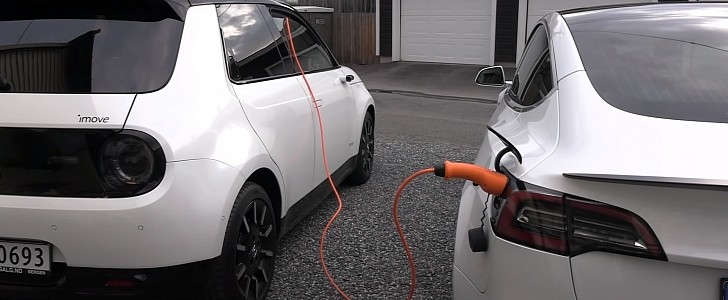The second most important thing that's keeping people from making the EV step after what they still consider to be a limited range is the availability of charging solutions. Which is kind of funny if you think about it considering power sockets outnumber gas stations something like a quadrillion to one.
Or, to put it in another way, there are no gas stations without power outlets, but there are countless sockets that don't have gasoline pouring out of them. I know because I have them in my house. And if mere household sockets aren't enough to satisfy you, the network of charging stations is expanding constantly with the maximum charging speed also growing every year.
That aside, we're not here to talk about conventional charging, but something that's made possible by a very simple yet brilliant idea from Honda e's makers. The tiny Japanese urban EV has an inverter and a 1.5 kW AC outlet, which can essentially make it a mobile charging station. A very cute one too.
As you would expect, though, it wouldn't be a highly efficient one. A 1.5 kW output is fine four your hairdryer, but if charging other EVs you're after, you're probably better off watching grass grow and then move on to observing paint dry: you won't be going anywhere quickly.
The test is done by none other than Bjørn Nyland, the EV enthusiast from Norway that has all sorts of crazy ideas, including testing the cargo space of all cars by seeing how many banana boxes their trunks can fit. This one is a lot more scientific, though, and it does offer us some actual numbers to work with.
The bottom line is that charging another EV - a Tesla Model 3 in this case - this way isn't just slow, but also pretty inefficient. You get a loss of about 25 percent, meaning the 28.5 kWh battery in the Honda e can only deliver a theoretical charge worth 21.3 kWh. We would imagine the system won't allow the battery to be sucked dry completely, so it's likely even less than that. As for how long that would take, well, it's a good thing they also have USB ports to charge up your phone as I hear Netflix drains the battery pretty quickly.
That aside, we're not here to talk about conventional charging, but something that's made possible by a very simple yet brilliant idea from Honda e's makers. The tiny Japanese urban EV has an inverter and a 1.5 kW AC outlet, which can essentially make it a mobile charging station. A very cute one too.
As you would expect, though, it wouldn't be a highly efficient one. A 1.5 kW output is fine four your hairdryer, but if charging other EVs you're after, you're probably better off watching grass grow and then move on to observing paint dry: you won't be going anywhere quickly.
The test is done by none other than Bjørn Nyland, the EV enthusiast from Norway that has all sorts of crazy ideas, including testing the cargo space of all cars by seeing how many banana boxes their trunks can fit. This one is a lot more scientific, though, and it does offer us some actual numbers to work with.
The bottom line is that charging another EV - a Tesla Model 3 in this case - this way isn't just slow, but also pretty inefficient. You get a loss of about 25 percent, meaning the 28.5 kWh battery in the Honda e can only deliver a theoretical charge worth 21.3 kWh. We would imagine the system won't allow the battery to be sucked dry completely, so it's likely even less than that. As for how long that would take, well, it's a good thing they also have USB ports to charge up your phone as I hear Netflix drains the battery pretty quickly.






















